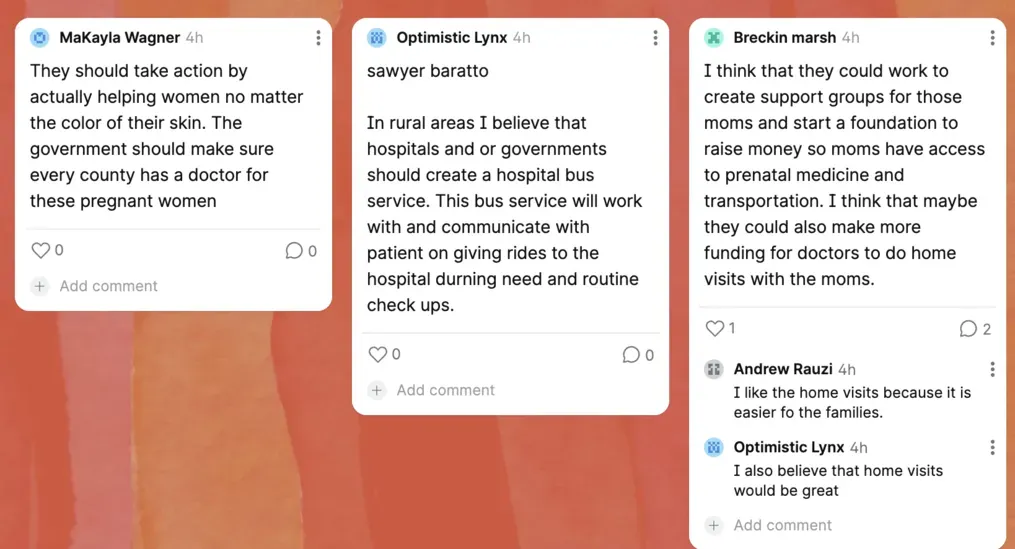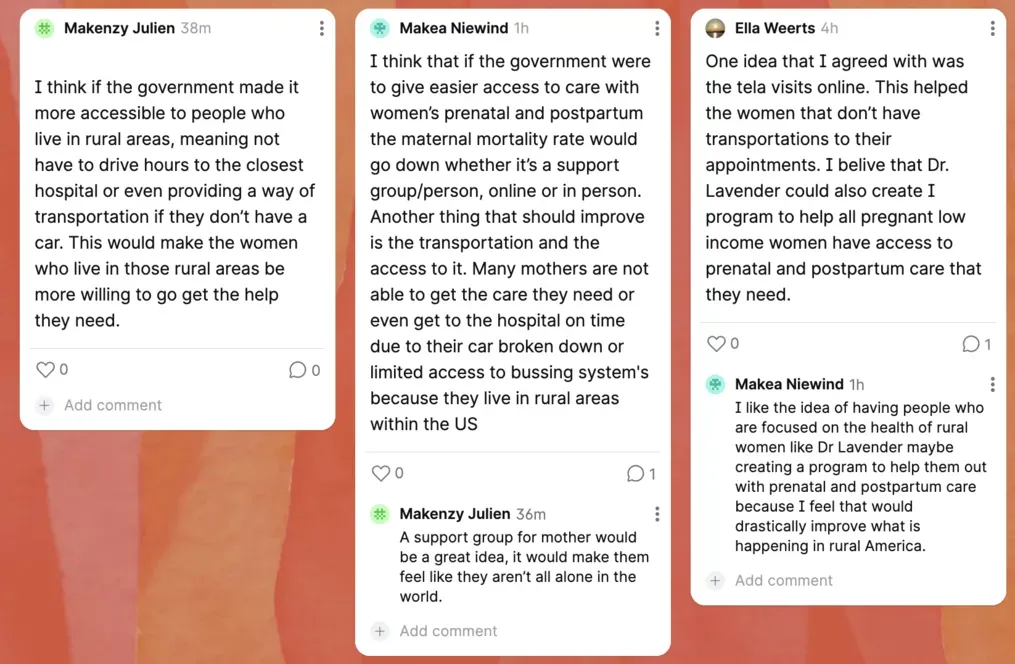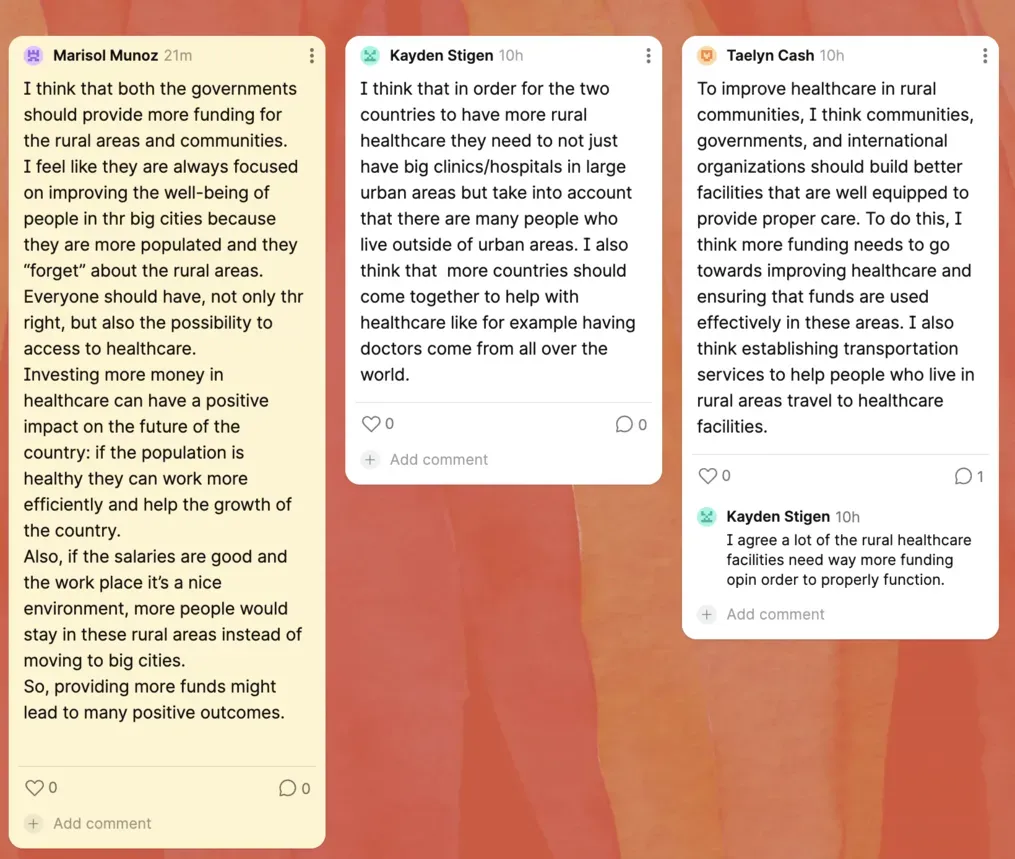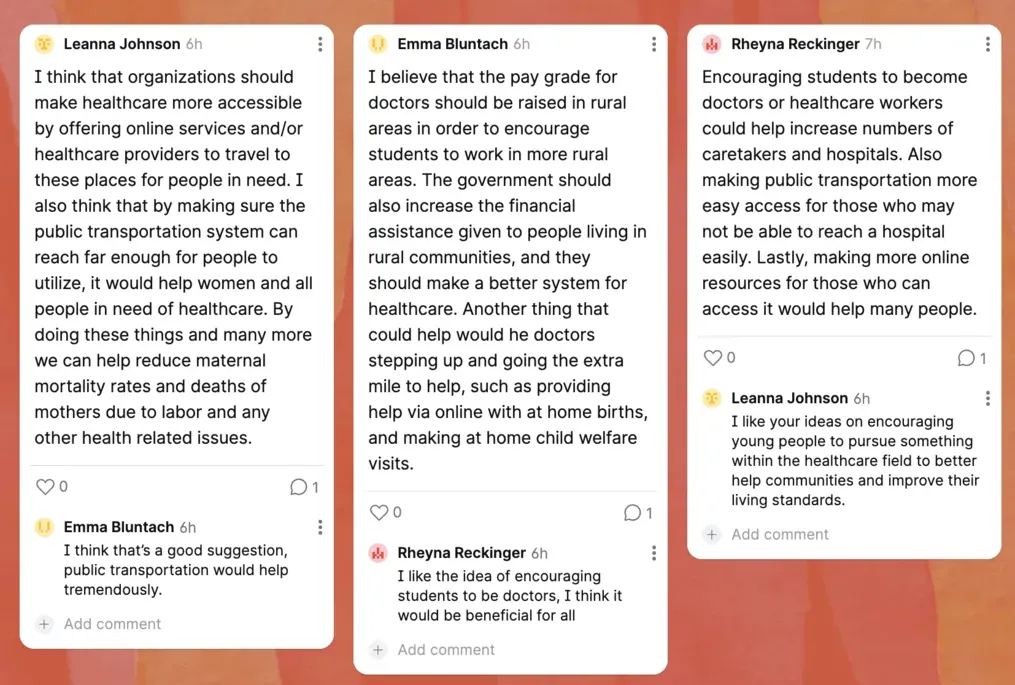This unit was created by Brielle Carlson, a high school social studies educator in rural, northeastern Minnesota, as part of the 2024 Pulitzer Center Global Health Teacher Fellowship program. It is designed for facilitation across three to four 50-minute class periods.
For more lessons created by Pulitzer Center Teacher Fellows in this cohort, click here.
"Teaching this lesson challenged my perceptions of the American healthcare system and made me think deeply about how health equity for anyone in the world has enormous impacts far beyond a person’s physical health. I’m hopeful that my students were able to at least start to comprehend the barriers to healthcare in the world and want to be part of the solution to work towards improving global health equity."
Brielle Carlson, social studies educator, minnesota
Lesson Overview:
As part of a larger unit on global development, students will consider how access to and the quality of healthcare has enormous implications for individuals, families, communities, and countries. As a significant portion of each country’s overall score on the Human Development Index (HDI), countries are individually measured on three elements:
- The ability of individuals to achieve a decent standard of living
- The ability to access education
- The ability to live a long and healthy life
In this lesson, students will explore examples of limited healthcare access in rural America and rural Nigeria, focusing on the disparities that exist between the two contexts.
They will begin by identifying key factors contributing to these differences, such as socioeconomic status, infrastructure, government policy, and cultural attitudes toward health. After engaging with a Pulitzer Center article and video, students will complete an analysis on each, with the lesson ending in a whole-class Padlet post or Fishbowl Discussion, where students can engage in a structured conversation about the barriers, challenges, and potential opportunities for improving healthcare access in rural areas. These formats will encourage students to share their insights from the Pulitzer article and videos, listen to diverse perspectives, and collaboratively explore solutions.
By the end of the lesson, students will not only have a deeper understanding of how healthcare disparities impact development within a global context but also the ability to think critically about global health issues.
Performance Task:
Students will participate in a Padlet post or Fishbowl Discussion engaging with the question: “In what ways should communities, governments, and international organizations take action to prioritize healthcare access in rural areas?”
Assessment:
Students will be assessed on their learnings with the following formative assessments:
- The completion of the Data Deep-dive: The Nigeria and the U.S. [.pdf][.docx] with discussion
- The completion of the Geographic Case Study Using Pulitzer Center Resources [.pdf][.docx]; one from “Rural Women Hit Hardest By Nigeria’s Worsening Health Care Crisis” and one from “The Health Care Challenges Pregnant Women of Color Face in Rural Areas”
Students will be assessed on their learnings with one of the following summative assessments:
- Padlet posts participation
- Participation quality in the Fishbowl Discussion. The rubric is included in the assignment sheet [.pdf][.docx].
Notes on Context & Content Advisory:
This lesson was developed for upper-level (junior/senior) advanced Geography course students. Discussions of healthcare topics, including childbirth and patient care.
This lesson was designed for an 11th/12th grade World Geography/International Baccalaureate Geography. Facilitation is suggested across three to four 50-minute class periods. This lesson plan includes pacing, texts and multimedia resources, teacher-created resources, suggestions for implementation, and rubrics for assessment.
Lesson Resources:
| Pulitzer Center Reporting | “Rural Women Hit Hardest By Nigeria’s Worsening Health Care Crisis,” by Taiwo Adebulu for The Cable “The Health Care Challenges Pregnant Women of Color Face in Rural Areas,” by Stephanie Sy and Maea Lenei Buhre for PBS NewsHour. Optional: “West Virginia Doctors Work to Bridge Healthcare Gap in Rural Areas,” by William Brangham, Janet Tobias, Caleb Hellerman and Courtney Norris for PBS NewsHour |
| Additional Digital Resources | CIA World Factbook Human Development Index from the United Nations Development Program website |
| Teacher-created Resources | Data Deep Dive: Nigeria and the U.S.[.pdf][.docx] Geographic Case Study Using Pulitzer Center Resources [.pdf][.docx] Global Healthcare Challenges Fishbowl Discussion [.pdf][.docx] |
Minnesota State Social Studies Standards
Geography:
9.3.15.2 Compare the population characteristics of places at a range of scales using population pyramids, birth and death rates, and other key demographic variables in major world regions.
9.3.17.4 Evaluate the impact of spatial decisions on policies affecting historically marginalized communities of color and Indigenous nations and take action to affect policy.
International Baccalaureate Geography Guide
International Baccalaureate Geography Requirement:
Option F: Food and Health
- Ways of measuring disparities in food and health between places
- The power of different stakeholders in relation to influence over diets and health
- Future possibilities for improved health
“I think that organizations should make healthcare more accessible by offering online services and/or healthcare providers to travel to these places for people in need. I also think that by making sure the public transportation system can reach far enough for people to utilize, it would help women and all people in need of healthcare. By doing these things and many more we can help reduce maternal mortality rates and deaths of mothers due to labor and any other health-related issues.”
Minnesota student from Carlson's class, Fall 2024
After analyzing reporting on global healthcare access, students engaged in a fishbowl discussion on Padlet responding to the question: In what ways should communities, governments, and international organizations take action to prioritize healthcare access in rural areas?




About Brielle Carlson
Brielle Carlson is a high school social studies educator at Grand Rapids High School in rural, northeastern Minnesota. She taught “The Complexities of Global Healthcare Access” to a class of 38 students.
By engaging in the video and article from the Pulitzer Center, I became more aware of health barriers for people in rural America even though I thought I knew what many of them were.
Brielle Carlson, 2024 Teacher Fellow
Tell us about you, your students, and your community.
I teach in northern, rural Minnesota in a predominantly white, Christian community with various socio-economic levels. As a social studies educator, I designed this lesson for an 11/12 International Baccalaureate World Geography class.
Tell us about your lesson.
As part of our Food and Health unit in World Geography, my students spend a substantial amount of time learning about disparities in food and health systems globally as well as the role of international organizations, governments, and communities in managing and addressing complications within these systems. We live in a rural community where, although a local hub of healthcare exists, many people struggle to access specialized medical care and have to travel long distances to receive services. This challenge is a tremendous barrier, especially for people who lack economic resources and/or reliable transportation. Additionally, our community struggles to attract young medical providers to the area. We also simply do not have enough doctors available for our local population, including OBGYNs.
I wanted to incorporate this local issue, which is very relevant to my students, into the Pulitzer Center reporting on rural healthcare access for women and families in Nigeria. Being able to capture and understand the struggles here in rural America, juxtaposed with those in Nigeria, is an opportunity for students to become aware of how significant accessible healthcare is for all people. Furthermore, I am hopeful that engaging with these two pieces of journalism can motivate students not only to identify the barriers to healthcare in rural spaces but also to seek solutions to these issues.
Tell us about what your students learned while engaging with the lesson.
For our cumulative task, students responded to the question, “In what ways should communities, governments, and international organizations take action to prioritize healthcare access in rural areas?” The following responses demonstrate the impact the lesson had on their understanding of healthcare access.
“I think that if the government were to give easier access to care with women’s prenatal and postpartum the maternal mortality rate would go down whether it’s a support group/person, online or in person. Another thing that should improve is the transportation and the access to it. Many mothers are not able to get the care they need or even get to the hospital on time due to their car broken down or limited access to bussing systems because they live in rural areas within the US.”
“One idea that I agreed with was the tele visits online. This helped the women that don’t have transportation to their appointments. I believe that Dr. Lavender could also create a program to help all pregnant low-income women have access to prenatal and postpartum care that they need.”
“In rural areas, I believe that hospitals and or governments should create a hospital bus service. This bus service will work with and communicate with patients on giving rides to the hospital during need and routine checkups”.
“They should take action by actually helping women no matter the color of their skin. The government should make sure every county has a doctor for these pregnant women.”
“Encouraging students to become doctors or healthcare workers could help increase numbers of caretakers and hospitals. Also making public transportation more easy access for those who may not be able to reach a hospital easily. Lastly, making more online resources for those who can access it would help many people.”
“I think that governments, especially in countries with large rural populations, should make a point to make healthcare accessible in rural locations. It’s difficult to find funding for these services, but I’m sure there are tons of people that would be willing to start a nonprofit to help. More hospitals could also implement things like the online prenatal checkups.”
“I think that organizations should make healthcare more accessible by offering online services and/or healthcare providers to travel to these places for people in need. I also think that by making sure the public transportation system can reach far enough for people to utilize, it would help women and all people in need of healthcare. By doing these things and many more we can help reduce maternal mortality rates and deaths of mothers due to labor and any other health-related issues.”
Tell us about what you learned by creating and teaching this lesson.
Through teaching this lesson, I have come to understand how undervalued access to excellent healthcare is. By engaging in the video and article from the Pulitzer Center, I became more aware of health barriers for people in rural America even though I thought I knew what many of them were. Teaching this lesson challenged my perceptions of the American healthcare system and made me think deeply about how health equity for anyone in the world has enormous impacts far beyond a person’s physical health. I’m hopeful that my students were able to at least start to comprehend the barriers to healthcare in the world and want to be part of the solution to work towards improving global health equity.
I learned that I needed far more time than I originally planned for my lesson (3 days). We could have spent at least 5, 50-minute class periods exploring this issue within our Geography course. For teachers that intend to teach this lesson, allow yourself more time than you think to answer student questions, to more deeply discuss things like unconscious bias in healthcare and the role of government in providing basic health necessities like electricity and medicines.



.png.webp?itok=tFWx8Uy1)








